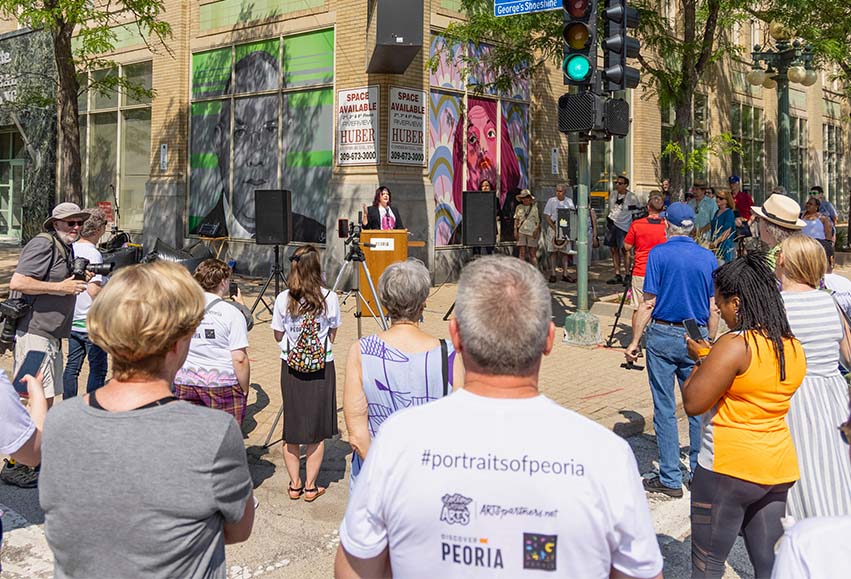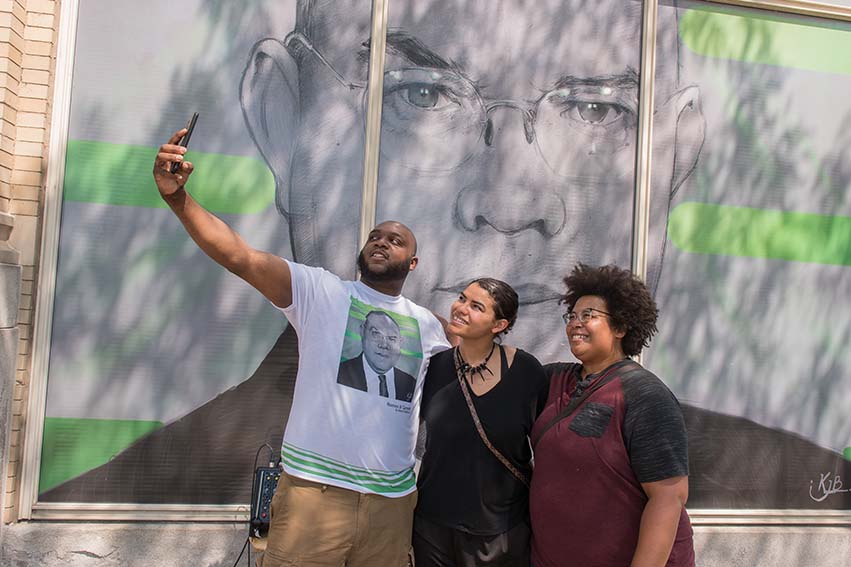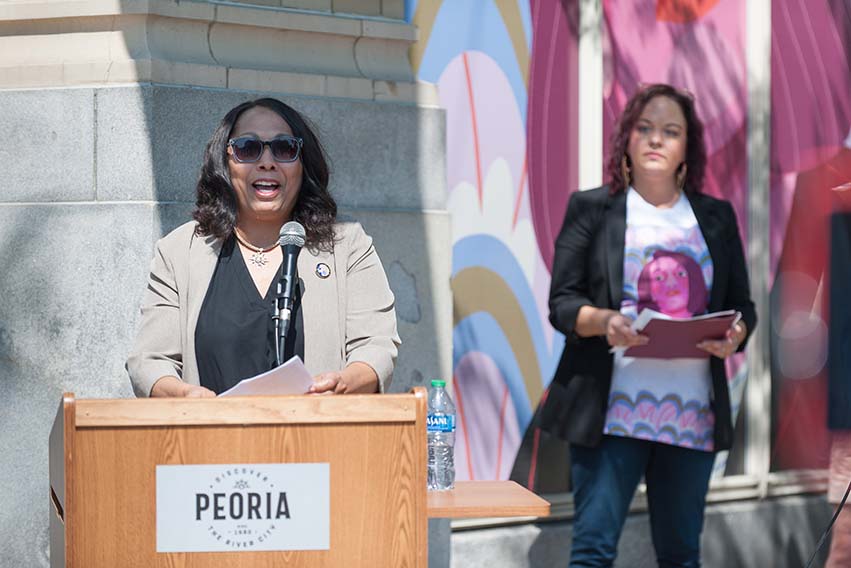
When developer Ray Becker passed away in 2020, I recalled a portion of his “Local Legends” interview from Peoria Magazine in which he addressed the cynical yet oft-spotted bumper stickers of the 1980s: “Would the last one to leave Peoria, please turn off the lights?” In response, Becker posted signs reading, “We’re keeping the lights on in Peoria.”
The leaders who keep the lights on in our community today are affected by the leaders of the past. As we look ahead to 2022 after a particularly tumultuous two years, we need those visionaries now more than ever. A new program, “Portraits of Peoria,” aims to celebrate the diverse and important contributions of notable people who called the Greater Peoria area home—who not only had an important impact locally, but nationally and globally as well. And for the participating artists, it has been an illuminating experience.
History Uncovered
Portraits of Peoria is a joint program between Big Picture Initiative, Discover Peoria and ArtsPartners of Central Illinois. The goal is to place murals of some of our city’s most storied leaders in the windows of the Central National Bank Building at the corner of Main and Adams in downtown Peoria. By doing so, the organizations hope to instill a sense of pride in our local identity.
Two portraits have already been unveiled: Dr. Romeo B. Garrett and Betty Friedan. Dr. Garrett was the first Black professor at Bradley University, a member of the Peoria NAACP, and associate minister of the Zion Baptist Church of Peoria for almost 40 years. More than 400 students have been able to attend Bradley University thanks to numerous scholarships created in his honor. Betty Friedan, who is credited with ushering in the second wave of feminism, wrote the bestseller The Feminine Mystique and co-founded the National Organization for Women. She was a force for change, and her work impacted women on a global scale. Yet these two Peorians, like many other important figures of our past, have had little public recognition of their impact locally.
Dr. Romeo B. Garrett and Betty Friedan were depicted by artists Kevin Bradford and Eliza Von Zerneck, respectively. “I knew that [Friedan] was a trailblazing feminist thinker from Peoria. I hadn’t read The Feminine Mystique, but I had seen her ideas referenced and repeated in other academic writing,” Von Zerneck recalls. “Before researching her further, I had the impression that her activism was very narrow; I thought her focus was just on liberating white, middle-class, married women who were stuck in the role of ‘housewife.’ But she was much more progressive than that! She really stood up for issues that affected all women, and she’s the reason for a lot of the freedoms that we enjoy today.”
Bradford had a similar revelatory experience when researching Dr. Garrett. “I was definitely familiar with Romeo, due to the street dedicated to him,” he notes, referencing Romeo B Garrett Avenue near downtown Peoria. “I also found out not only that the last residential house on [that road] was actually his home, but I had been inside and know a relative of his!”

Six additional portraits will be placed on the same building later this year. One in particular, Nance Legins-Costley, already meant a great deal to the artist depicting her: Preston Jackson. Legins-Costley was the first African American slave freed by then-attorney Abraham Lincoln in 1841—20 years before the American Civil War. She lived in Pekin, contributed significantly to the community, and died in 1892. It is believed that she was buried at Moffatt Cemetery, which is now a paved-over lot on the south end of Peoria. “The story of Nance gives us an idea of how people lived in other times,” Jackson notes, “and causes us to remember the value of a free society through others’ lives.”
Fiber artist Trish Williams is depicting Annie Malone, one of the first (and possibly the first) Black women millionaires. She was a shrewd businesswoman, philanthropist and entrepreneur who founded and developed a prominent commercial enterprise centered around cosmetics for Black women. Williams quilted her portrait, resulting in an intricate and stunning piece. For her, it was a deeply personal experience. “What was unique for me as an artist was spending time with the grand-nephew of Annie Malone and learning on a personal level who she was to the family and community,” she reflects.
Another new portrait will highlight Peoria’s radio superstar couple: Jim and Marian Jordan, better known as “Fibber McGee and Molly.” Like Richard Pryor, the Jordans left Peoria before they became famous, but they stayed in touch and embraced their roots here. The duo had a popular NBC radio comedy series from 1935 to 1959 and even starred in films like Look Who’s Laughing, appearing alongside the legendary Lucille Ball. References to their hometown of Peoria appeared regularly in the Jordans’ sketches, and locals back home found a sense of pride in their work.
Artist Bob Doucette says that he joined the Fibber McGee and Molly fan club while researching the couple for their portrait. “They are very excited to see the mural; they can’t believe that Peoria has never done anything to honor them, as they were as famous as I Love Lucy in their day!” A transplant from Los Angeles, Doucette wants others to recognize Peoria’s excellence. “I hope my painting inspires people to find out more about the subject, take more pride in Peoria’s past, and get excited about Peoria now and what a rich community it is.”

Teaching Through Art
As these artists so acutely understand, public art is a powerful force. It has played a distinguishing role in our country’s history and culture, reflecting and revealing who we are as a society. It makes communities unique and humanizes the built environment around us. And importantly, it provides an intersection between past, present and future, as well as between disciplines and ideas.
“Public art is a constant reminder of who we are and what’s happening around us—it tells our story like a powerful newspaper. It is a barometer or compass telling where we are as a society,” Preston Jackson reflects. “It speaks to us and attempts to keep us civil.”
Public art is also a draw for tourists, an important part of the local economy. As Bob Doucette points out, “It attracts people from outside of your city to visit and possibly spend money in your town—or perhaps even move to your town! It also gives the town an identity and a personality that enriches the lives of those who live there.”
And the data backs this up. According to a study by Americans for the Arts, the nonprofit arts industry generates $166.3 billion in economic activity each year. Studies have shown that cities with a high concentration of the arts also have higher civic engagement, more social cohesion, higher child welfare and lower poverty rates. That is why public art programs like Portraits of Peoria are so important: they celebrate who we are, while pointing us toward a more positive future.
“People do not think about the past as significant, but it is,” notes Doug Leunig, cofounder and board president of Big Picture Initiative. “It sets the tone for who we are and what we become.”
In addition to the portraits mentioned above, Portraits of Peoria will feature artist Jeremy Berkley's depiction of former Caterpillar president Bob Gilmore, who left a legacy of local philanthropy through the Gilmore Foundation. An additional portrait will be revealed in the months to come. Going forward, the hope is to expand the program to include more murals throughout the area with the help of public donations and support.
“The Portraits of Peoria program has graced Peoria’s downtown with big pictures of amazing people,” notes Mayor Rita Ali, “and given us a reason to pause and reflect upon their image and their impact.” PM
Mae Gilliland Wright, PhD, is executive director of Big Picture Initiative, a nonprofit organization that believes art can change the world—starting with our community. To learn more, visit bigpicturepeoria.org/portraits-of-peoria.
- Log in to post comments

